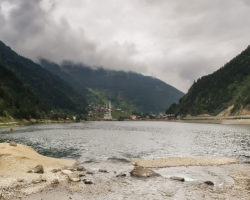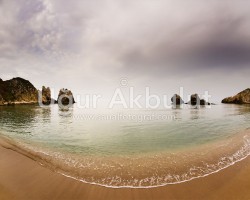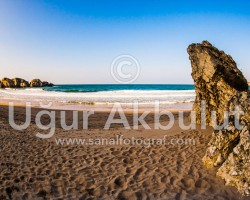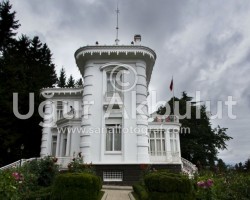[kml_flashembed publishmethod=”static” fversion=”8.0.0″ movie=”https://www.sanalfotograf.com/ugurakbulut/sumela-manastiri-avlu-1.swf” width=”100%” height=”556″ targetclass=”flashmovie” allowfullscreen=”true”]
[/kml_flashembed]
| Trabzon ili, Maçka ilçesi, Altındere köyü sınırları içerisinde yer alan Panagia (Meryemana) deresinin batısında ve kilise kompleksi olup, tam adı Panagia Sumela (Παναγία Σουμελά) veya Theotokos Sumeladır.Sümela Manastırı, 1903Kilisenin MS 375-395 tarihleri arasında inşa edildiği sanılmaktadır. Anadolu’da sıkça rastlanılan Kapadokya kiliseleri tarzında yapılmış, hatta Trabzon’da Maşatlık mevkiinde benzeri bir mağara kilisesi daha vardır. Kilisenin ilk kuruluşu ile manastır haline dönüşümü arasındaki bin yıllık dönem hakkında fazla bir şey bilinmemektedir. Karadeniz Rumları arasında anlatılan bir efsaneye göre Atina’lı Barnabas ile Sophronios adlı iki keşiş aynı rüyayı görmüşler; rüyalarında, İsa’nın öğrencilerinden Aziz Luka’ın yaptığı üç Panagia ikonundan, Meryem’in bebek İsa’yı kollarında tuttuğu ikonun bulunduğu yer olarak Sümela’nın yerini görmüşler. Bunun üzerine birbirlerinden habersiz olarak deniz yoluyla Trabzon’a gelmiş, orada karşılaşıp gördükleri rüyaları birbirlerine anlatmış ve ilk kilisenin temelini atmışlardır. Bununla birlikte manastırdaki fresklerde sıkça yer alıp, özel bir önem verilen Trabzon İmparatoru III. Alexios’un (1349-1390) manastırın gerçek kurucusu olduğu sanılmaktadır.
14. yüzyılda Türkmen akınlarına maruz kalan kentin savunmasında ileri karakol görevi üstlenen manastırın statüsünde Osmanlı fethinden sonra bir değişiklik olmamıştır. Yavuz Sultan Selim’in Trabzon’da ki şehzadeliği sırasında iki büyük şamdan buraya hediye ettiği, Fatih Sultan Mehmed, II. Murat, I. Selim, II. Selim, III. Murad, İbrahim, IV. Mehmed, II. Süleyman ve III. Ahmed’in de manastırla ilgili birer fermanları bulunmaktadır. Osmanlı döneminde manastıra sağlanan imtiyazlar, Trabzon ve Gümüşhane bölgesinin İslamlaşması sırasında özellikle Maçka ve kuzey Gümüşhane’de Hristiyan ve gizli Hristiyan köyleri ile çevrili bir alan yaratmıştır. 18 Nisan 1916’dan 24 Şubat 1918’e kadar süren Rus işgali sırasında Maçka civarındaki diğer manastırlar gibi bağımsız bir Pontus devleti kurmak isteyen Rum milislerin karargahı olmuş, nüfus mübadelesi ile bölgedeki Hristiyanların Yunanistan’a gönderilmesinin ardından önemini yitirerek T.C. Kültür Bakanlığı tarafından yakın zamanda onarılana dek kaderine terkedilmiştir. Yunanistan’a mübadele ile göçen Karadenizli Rumlar Veria kentinde Sümela adını verdikleri yeni bir kilise inşa etmişlerdir. Her yıl Ağustos ayında tıpkı geçmişte Trabzon Sümela’da yaptıkları gibi yeni manastırın çevresinde geniş katılımlı şenlikler düzenlemektedirler. “Sümela Manastırı.” Wikipedia, Özgür Ansiklopedi. 18 Ağu 2009, 13:51 UTC. 24 Ağu 2009, 11:55 <http://tr.wikipedia.org/w/index.php?title=S%C3%BCmela_Manast%C4%B1r%C4%B1&oldid=6232276>. ———————————————————————————————————————————————————————— ENGLISH The Sümela Monastery (Greek: Μονή Σουμελά, Turkish: Sümela Manastırı) stands at the foot of a steep cliff facing the Altındere valley in the region of Maçka in Trabzon Province, modern Turkey. Lying at an altitude of approximately 1200 metres, it is a major tourist attraction of Altındere National Park. Founded in the year 386 AD during the reign of the Emperor Theodosius I (375 – 395),[1] legend has it that two priests undertook the founding of the monastery on the site after having discovered a miraculous icon of the Virgin Mary in a cave on the mountain. During its long history, the monastery fell into ruin several times and was restored by various Emperors. During the 6th Century AD, it was restored and enlarged by General Belisarius at the behest of Justinian.[1] It reached its present form in the 13th century after gaining prominence during the reign of Alexios III (1349 – 1390) of the Komnenian Empire of Trebizond (established in 1204). At that time, the monastery was granted an amount annually from imperial funds. During the time of Manuel III, son of Alexius III, and during the reigns of subsequent princes, Sümela gained further wealth from imperial grants. Following the conquest by the Ottoman Sultan Mehmed II in 1461, it was granted protection by order of the Sultan and given rights and privileges which were renewed by following sultans. Monks and travelers continued to journey there through the years, the monastery remaining extremely popular up until the 19th century. The Monastery was seized by the Russian Empire during the occupation of Trabzon in the years 1916-1918. The site was finally abandoned in 1923, following the population exchanges between Greece and Turkey after the Treaty of Lausanne. In 1930, the miraculous icon of the Panagia Soumelá, as well as other sacred treasures of the monastery, were transferred to the new Panagia Soumela Monastery, on the slopes of Mount Vermion, near the town of Naousa, in Macedonia, Greece. Today the monastery’s primary function is as a tourist attraction. Its place overlooking the forests and streams below, make it extremely popular for its aesthetic attraction as well as for its cultural and religious significance. Currently restoration works funded by the Turkish government are taking place. Construction and buildings The principal elements of the Monastery complex are the Rock Church, several chapels, kitchens, student rooms, a guesthouse, a library, and a sacred spring revered by Orthodox Greeks. The large aqueduct at the entrance, which supplied water to the Monastery, is constructed against the side of the cliff. The aqueduct has many arches which have mostly been restored. The entrance to the Monastery leads up a long and narrow stairway. There is a guard-room next to the entrance. The stairs lead down from there to the inner courtyard. On the left, in front of a cave, there are several monastery buildings. The cave, which was converted into a church, constitutes the centre of the monastery. The library is to the right. The large building with a balcony on the front part of the cliff was used for the monks’ cells and for housing guests. It dates from 1840. The influence of Turkish[citation needed] art can be observed in the design of the cupboards, niches and fire-place in the rooms of the buildings surrounding the courtyard. The inner and outer walls of the Rock Church and the walls of the adjacent chapel are decorated with frescoes. Frescoes dating from the era of [Alexios III] line the inner wall of the Rock Church facing the courtyard. The frescoes of the chapel which were painted on three levels in three different periods are dated to the beginning of the 18th century. The frescoes of the bottom band are of superior quality. The frescoes of the Sümela Monastery are seriously damaged, having largely been moved from their original settings. The main subject of the frescoes are biblical scenes telling the story of Christ and the Virgin Mary. Wikipedia contributors. “Sümela Monastery.” Wikipedia, The Free Encyclopedia. Wikipedia, The Free Encyclopedia, 6 Jul. 2010. Web. 7 Jul. 2010. |
|






Bu yaz sizden sonra yani eylül ayında ben de ilk kez gittim oraya süper bir yer. Yani düşününki zamanında rüyasında gören iki kişi buluşup konuşuyorlar ve Denizden uzak bir yerde kayalara adeta bi kent oyuyorlar. İnsanlar ne hayaller kuruyormuş o zaman neler yapıyorlarmış şimdi gidip gören için çok farklı ve etkileyici.